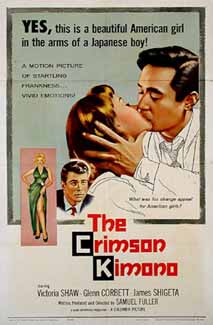
THE CRIMSON KIMONO
US, 1959, 82 minutes, Black and white.
Victoria Shaw, Glenn Corbett, James Shigeta, Anna Lee.
Directed by Sam Fuller.
The Crimson Kimono has a good reputation as a film noir from the end of the 1950s. It was written and directed by Sam Fuller, with a reputation for hard-hitting screenplays and direction. His earlier films include Park Row and The Pickup on South Street. In the 1960s he made an impact with The Naked Kiss and Shock Corridor. His autobiographical The Big Red One was a significant World War Two film of 1980. Fuller has attained a strong reputation amongst cinema buffs and students of film.
This film is set in Japan Town in Los Angeles, a sleazy area, a strip club, a world of artists. Victoria Shaw (Australia’s Jeanette Elphick who went to Hollywood in such films as The Eddy Duchin Story and The Edge of Eternity) is an artist. Glenn Corbett (in his first film) and James Shigeta are two detectives investigating the murder of a stripper. They both fall in love with the artist. Since one is Japanese -American and the other American -American, and though they served together in World War Two, the interracial themes are raised quite significantly and strongly. Anna Lee portrays an eccentric artist.
The film is strong on atmosphere, atmospheric black and white photography, angles and close-ups, chases. The personal confrontations between the central characters are quite strong.
The film is interesting as coming fourteen years after the end of World War Two, a focus on Japanese -American relationships, especially for the American -Japanese and the way that they were treated during the war.
1.The reputation of Sam Fuller, his writing, directing? Characteristics? Strong, direct, confrontational?
2.The Japan Town setting in Los Angeles? The sleazy streets, the clubs? The contrast with the studios of the artists? The range of characters in Japan Town? The musical score?
3.The focus on Sugar Torch, the outside of the theatre, her performance, her manager, the confrontation, her running away, being shot in the street? The mystery of the portrait of her, the mystery of who would kill her? The revelation of the plan for a Japanese performance, the various advisers, the painting?
4.Charlie and Joe as the detectives? Their background in World War Two, the blood transfusion from Charlie to Joe? As partners? The discussions with Mac, with the proprietor of the club, the various connections with Sugar Torch? Their discovering that the signature on the paintings was Christine? Meeting her, getting the background of the painting, her work? Each falling in love with her? Her response?
5.Mac, drinking, the eccentric artist? Her husband? Her friendship with Christine? Advice on painting? The discussions and help with the detecting? The final revelation about her husband, her judging him wrongly her shooting Sugar Torch? The chase in the parade at the end? The final glimpse of her?
6.Joe, in love with Chris, the effect on him, words indicating racial attitudes, his misinterpretations, his clash with Charlie? The formal clash in the martial arts confrontation? His discussions with Chris, her trying to make him understand? His enlightenment when he realised that Mac had misjudged appearances and her husband?
7.Charlie, tough, the detection work, working with Joe? His language, his explanations of his envy, reasonable? The tension between them? The possibilities of friendship for the future?
8.The variety of characters in Japan Town? The proprietor of the club? The patron giving money for the development of the performance? Hansel and his connections, his being misjudged?
9.An effective film noir – at the period when this kind of film, post-war drama, was coming to an end?